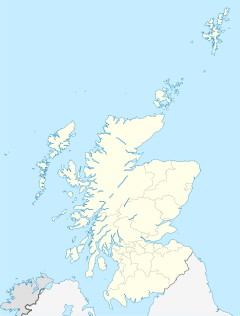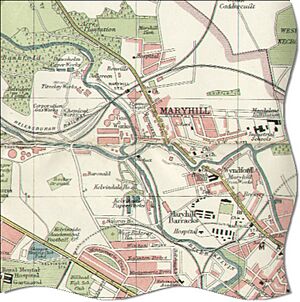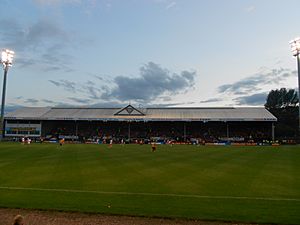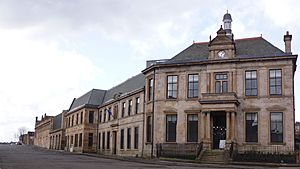Maryhill facts for kids
Quick facts for kids Maryhill
|
|
|---|---|
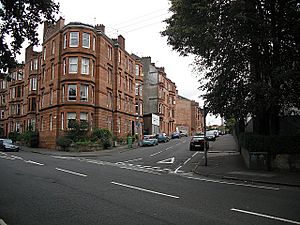 Shakespeare Street |
|
 Flag |
|
| OS grid reference | NS563691 |
| Council area | |
| Lieutenancy area | |
| Country | Scotland |
| Sovereign state | United Kingdom |
| Post town | GLASGOW |
| Postcode district | G20 |
| Dialling code | 0141 945/946 |
| Ambulance | Scottish |
| EU Parliament | Scotland |
| UK Parliament | |
| Scottish Parliament | |
Maryhill (Scottish Gaelic: Cnoc Màiri) is an area in the north-west of Glasgow in Scotland. It used to be a separate town, or burgh. Maryhill Road, which is part of the A81 road, runs through the middle of the area for about 3 miles (5 km). It connects Glasgow city centre to the nearby town of Bearsden.
Maryhill railway station serves the far north-west part of Maryhill.
Contents
History of Maryhill
The story of Maryhill began with a woman named Mary Hill (1730–1809). Her father, Hew Hill, was the Lord of Gairbraid, and he left his land to her because he had no sons. Mary married Robert Graham in 1763. They didn't earn much money from other jobs, so they tried to make money from their land. They opened coalmines, but these didn't make a profit.
A big change happened on March 8, 1768. The government approved a plan to build the Forth and Clyde Canal right through their land. This project brought them some much-needed money. The canal reached their estate in 1775, but then work stopped for eight years because the canal company ran out of money.
The government later provided more funds, and construction started again. A huge building project began where the canal crossed the River Kelvin. Workers built five locks (like water elevators for boats), the large Kelvin Aqueduct, and a dry dock for repairing boats. A small village started to grow around this busy area. Robert Graham, Mary's husband, gave more land for the village to expand. He made one special rule: the village would always be called "the town of MaryHill" to honor his wife, Mary Hill.
The new canal attracted many businesses. Boat-building, sawmills, and iron factories opened along its banks in Mary's estate. By 1830, the scattered houses had grown into a large village with 3,000 people. The Glasgow, Dumbarton and Helensburgh Railway was built through Maryhill in the 1850s, bringing even more growth.
In 1856, Maryhill became its own town, or burgh. However, in 1891, it became part of the larger city of Glasgow.
Part of the ancient Antonine Wall, built by the Romans, runs through Maryhill. In the Maryhill Park area, you can find the site of a Roman fort and a Roman bath-house nearby.
Maryhill was home to one of the first Temperance Societies in Scotland. These groups encouraged people to drink less alcohol.
Maryhill also has one of Glasgow's original Carnegie libraries. These libraries were built with money from a famous businessman named Andrew Carnegie.
Maryhill Barracks opened in 1872. It was a large army base that used to cover the area where the Wyndford housing estate is now. It was home to famous army units like the Scots Greys. During World War II, Adolf Hitler's second-in-command, Rudolf Hess, was held there. The barracks closed in 1959 and were taken down in 1961. However, a modern army reserve unit, the 52nd Lowland Volunteers, is still based at the nearby Walcheren Barracks.
Geography of Maryhill
The Maryhill area is made up of several smaller parts, often called sub-districts. These include Acre, Botany, Dawsholm Park, Firhill, Gairbraid, Gilshochill, Maryhill Park, North Kelvinside, Queen's Cross, St George's Cross, Cadder, Summerston, Woodside, and Wyndford.
How Maryhill is Governed
Maryhill is part of the Glasgow Maryhill and Springburn area for the Scottish Parliament. This means people in Maryhill vote for a Member of the Scottish Parliament (MSP) to represent them. The current MSP for Maryhill and Springburn is Bob Doris.
For the UK Parliament, Maryhill is part of the Glasgow North constituency. People here vote for a Member of Parliament (MP) to represent them in the House of Commons. The current MP for Glasgow North is Patrick Grady.
Maryhill is also a "Ward" (Ward 15) on the Glasgow City Council. A ward is a local area that elects councillors to manage local services. Maryhill Ward has three councillors: Abdul Bostani, Keiran O'Neill, and Franny Scally.
Population of Maryhill
In 2015, the population of the Glasgow Maryhill and Springburn area was about 73,493 people. In 2013, the population of the Maryhill/Kelvin Ward was about 27,125. Most people in Maryhill are White Scottish or British. However, Maryhill is also home to many different ethnic groups, including Chinese and African communities.
Economy in Maryhill
Maryhill has traditionally been an area where many people worked in factories or manual jobs. However, by 2013, more people in Maryhill worked in professional services (like offices or healthcare) than in manufacturing or construction. In 2011, there were about 18,770 people aged 16–64 who could work. Of these, about 13,237 were actively working or looking for work.
Some areas in Maryhill have lower average incomes compared to other parts of Glasgow. About 25% of people in Maryhill experience income deprivation, which means they have lower incomes.
Housing in Maryhill
Maryhill is in the north-west of Glasgow and has a mix of different types of homes. You can find traditional "Glaswegian" sandstone buildings called tenements. These often have high ceilings. There are also many large Victorian townhouses. In addition, there are large housing estates managed by housing associations.
The Wyndford and Gairbraid estate is a large housing area in Maryhill. It has almost 5,000 residents. This estate includes several tall high-rise buildings, with the tallest four reaching 26 storeys high. There are also smaller homes mixed in, creating a variety of housing types.
Sport in Maryhill
Maryhill is famous for being the home of Firhill Stadium. This stadium has been the home ground for Scottish Championship football club Partick Thistle since 1909. The club originally came from the area of Partick but moved to Maryhill.
Firhill Stadium has also been a temporary home for other football clubs like Clyde and Hamilton Academical in the past. Queens Park also played matches there in 2021–22.
From 2005 to 2012, Firhill was also the home of the professional Rugby Union team Glasgow Warriors. They later moved to Scotstoun Stadium. Maryhill is also home to the West of Scotland Football League team, Maryhill F.C., and Glasgow's oldest running athletic club, Maryhill Harriers.
Architecture, Canalside, and Modernisation
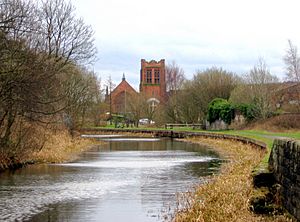
The famous architect Charles Rennie Mackintosh designed the Ruchill Church Hall, which is located in Maryhill.
The Forth and Clyde Canal flows through Maryhill. This canal was once very important for the local economy, helping businesses transport goods. After heavy industries declined, the canal became polluted and wasn't used much. However, in recent years, there have been efforts to clean up and reopen the canal for boats. A new footbridge was built across the canal at Stockingfield Junction in 2022, making it easier to connect to the Ruchill and Gilshochill areas.
The Maryhill Burgh Halls have twenty unique stained glass windows. These windows were made by Stephen Adam in 1878 and show the many different jobs and industries of the people who lived in Maryhill. The Burgh Halls, along with other historic buildings like the old Baths & Wash-houses, Fire Station, and Police Station, were restored in a big project costing £9.2 million. Some of the original stained glass windows have been on display since late 2011.
The Maryhill Lochs, which are part of the canal, were the location for the 2017 Red Bull Neptune Race, a special boat race.
Subdivisions of Maryhill
Botany
Botany (55°53′27″N 4°17′34″W / 55.8909°N 4.2929°W) is an area within Maryhill. One idea for how it got its name is that it was seen as a tougher part of Maryhill. Many people thought its residents might be sent to Botany Bay in Australia, which was a place where prisoners were sent. However, a simpler explanation is that there was a school in the area called the Botany School, and the name stuck even after the school closed.
The area has been completely redeveloped by the city council. New modern apartment flats are being built there, just like in many other parts of Maryhill.
The name of the area is remembered by a local bar called The Botany.
Maryhill Park
Maryhill Park (55°54′09″N 4°18′06″W / 55.9025°N 4.3016°W) is another area of Maryhill. Unlike some other parts of Maryhill, most people living here are middle-class. The homes in this area are mainly large Victorian semi-detached houses. The Maryhill Locks, which are a series of pools on the Forth & Clyde Canal that go steeply downhill, are located nearby.
The current Maryhill railway station was once called Maryhill Park. This was to tell it apart from another Maryhill railway station that was located further down Maryhill Road. Both stations closed in the 1960s. When the former Maryhill Park station reopened in the 1990s, the "Park" part of the name was removed because the other station did not reopen. Many bus routes along Maryhill Road also serve this area.
Queen's Cross
Queen's Cross is a neighborhood in Maryhill. It is mostly made up of social housing, which is housing provided by the local housing authority, Queen's Cross Housing Association.
The "cross" refers to the junction where Maryhill Road and Garscube Road meet. This junction extends south to the nearby areas of St George's Cross and Cowcaddens. The area's Queen's Cross Church was designed by the famous Glasgow architect Charles Rennie Mackintosh. It also serves as the main office for the Charles Rennie Mackintosh Society.
Maryhill in the Media
Maryhill has been used as a setting for several television shows and films:
- A TV show from the 1960s called High Living was set in a tall building in the Wyndford area of Maryhill.
- Taggart, a very famous detective show from Glasgow, was set and filmed in Maryhill. This show has been translated into many languages around the world.
- In the film Trainspotting, a cafe in Maryhill called Jaconelli's (near Queen's Cross) was used as a film set. Also, the pub called Crosslands on Queen Margaret Drive was where a fight scene took place.
- The popular BBC comedy series Chewin' the Fat was filmed in the area. Its follow-up show, the sitcom Still Game, also filmed scenes there.
Notable People from Maryhill
Many well-known people have connections to Maryhill:
- Jamesina Anderson, a politician
- Bertie Auld, a footballer
- Maggie Bell, a blues-rock singer
- Sean Biggerstaff, an actor
- Robert Carlyle, an actor
- Donovan, a singer-songwriter
- Jim Duffy, a footballer
- John Maxwell Geddes (1941–2017), a composer
- Archibald Lyle, a footballer
- Duncan Macrae, an actor
- David McCallum, an actor and musician
- Charlie Nicholas, a footballer
- Jerry Reynolds, a footballer
- George Ritchie, a footballer
- Andrew Robertson, a footballer
- Robert Smith, Baron Smith of Kelvin, a businessman
See also


